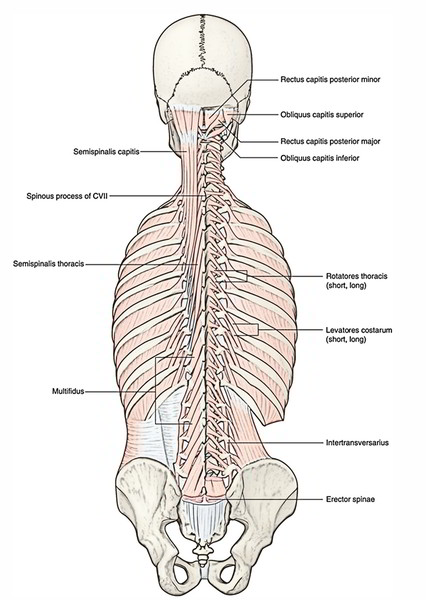The Multifidus muscles is the second group of muscles towards the semispinalis situated deep within this group, span the length of the vertebral column, going through a lateral point of beginning upwards then medially in order to connect with spinous processes and also extending amongst two and four vertebrae. The multifidus muscles are better formed within the lumbar region but occur all over the length of the vertebral column.

Multifidus Muscles
Structure
The multifidus muscle group, like its name suggests, is divided within several bundles. This muscle is large as well as thick within the lumbar region and is vital in sustaining the lumbar curve. It expands and also laterally flexes the vertebral column. The multifidus is among the transversospinales group. The multifidus muscle includes a several fleshy as well as tendinous fasciculi, which through the sacrum towards the axis fills the groove on both sides of the spinous protrusions of the vertebrae. Situated simply superficially towards the spine itself, the multifidus muscle stretches over three joint segments and also works to balance these joints at every level. These fasciculi arise:
- Sacral region
- Via the back of the sacrum, as low as the fourth sacral foramen
- Via the aponeurosis of beginning of the Sacrospinalis
- Via the medial side of the posterior superior iliac spine
- Via the posterior sacroiliac ligaments
- Lumbar region
- Through all the mamillary protuberances.
- Thoracic region
- Through all the transverse protuberances.
- Cervical region
- Through the articular protuberances of the lower four vertebrae.
Innervation
By the medial section of the dorsal ramus of the vertebra under it each fascicle of a given vertebra has a different innervation.
Functions
- The firmness and balance makes each vertebra work more efficiently, and as a result of friction through normal physical exertion decreases the deterioration of the joint structures.
- The multifidus is said for being vital for lumbar stability of the deeply positioned intersegmental muscles.
- Superficial multifidus collaborates with the erector spinae and varies according to the trajectory of arm movement.
- The deep multifidus collaborates with the transversus abdominis, and these muscles are effective equally whatever the arm movement direction.
- Also the action of specific parts of the multifidus is unique according to the body’s readiness for the task, that is, whether the subject is anticipating the movement as if the body was attempting to fine-tune its balance response.

 (54 votes, average: 4.55 out of 5)
(54 votes, average: 4.55 out of 5)